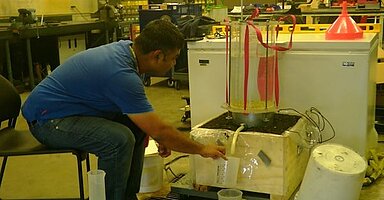Snowmelt water infiltration into frozen soil in the Red River of the North Basin

Debjit Roy is a Ph.D. graduate student in the Agricultural and Biosystems Engineering (ABEN) program at North Dakota State University (NDSU). He achieved his undergraduate degree in Agricultural Engineering from Bangladesh Agricultural University and earned his M.Sc. Engineering degree in Water Resources Engineering from Bangladesh University of Engineering and Technology. He is currently doing research on infiltration and soil-water-temperature interaction in frozen soil. His research findings will be used to overcome the current obstacles in order to accurately predict spring flood.
Email: debjit.roy@ndsu.edu
Fellow: Debjit Roy
Advisor: Xinhua Jia, Ph.D., P.E.; Associate Professor, Department of Agricultural and Biosystems Engineering, North Dakota State University.
Degree Progress:Ph.D. in Agricultural and Biosystems Engineering, expected graduation Spring 2017
Snowmelt water infiltration into frozen soil in Red River of the North Basin
Snowmelt water infiltration into frozen soil is an important but complicated process that can affect surface water runoff and groundwater recharge. Many factors, such as soil moisture, soil temperature, water release rate from the snow cover, energy content of infiltrating water, porosity, soil cracks, presence or absence of macropores and also complex processes of heat and mass transfer through the frozen soils affect the total infiltration process into frozen soils. In northern hemisphere, nearly 60 percent of the land surfaces are seasonally frozen and North Dakota is a part of that area. There is no simple and clear answer on how water infiltrates into frozen soil. The lack of understanding of the infiltration process into frozen soil is the major limiting factor affecting spring flood forecasting. In recent years, during the spring flood events in the Red River of the North Basin (RRB), flood forecasting cannot be estimated accurately due to lack of data on infiltration into frozen soil. Any error in flood prediction can cause significant financial losses and threaten 200,000 people lives in the Fargo-Moorhead metro area as well as people and animals in the entire basin. The proposed research project will focus on snowmelt infiltration characteristics into frozen soils. The outcomes from this study will give a better understanding about the infiltration process into frozen soils of RRB. It would also help to understand the runoff processes and RRB flooding events in spring.
Project Objectives:
The research project will focus on snowmelt infiltration measurement and simulation into frozen soil of RRB. The specific objectives of the research study are:
- To measure infiltration amount/rate into frozen soil at field and compare to that of the unfrozen soil
- To measure infiltration amount/rate into frozen soil at different soil moisture conditions at laboratory
- To simulate infiltration rate in frozen soil by available hydrological model and compare outputs with field observed data
- To measure infiltration rate relationship with hydraulic conductivity in frozen condition for different soils of RRB and incorporate that relationship in an existing hydrological model
Progress:
In total, twenty one infiltration field tests were conducted in tile drained and undrained fields of North Moorhead, MN and Fairmount, ND sites using Cornell sprinkler infiltrometer in frozen and unfrozen fields in 2014 and 2015. Soil moisture contents were recorded during the tests using Hydra Probe II sensors. Six soil box infiltration experiments were conducted in 2015. A wooden box (50 cm L, X 50 cm W X 30 cm D) was packed layer by layer with field soil for each experiment by maintaining a same soil bulk density. Soil moistures at field capacity, at halfway between permanent wilting point and field capacity; and at wilting point are taken as moisture treatments for the experiments. 5TE soil moisture and temperature sensors (Decagon Devices) have been installed at 11, 17, and 23 cm depth of the soil box. The soil moistures and temperatures are continuously recorded by a data-logger during the experiment period. Infiltration experiments were carried out using Cornell sprinkler infiltrometer until infiltration water reaches the bottom soil moisture sensor. Soil physical properties were determined using soil cores collected from the field. Soil water release curves (SWRC) were determined using Hyprop (Version 10/2011, UMS GmbH Munchen) and WP4 Dewpoint Potentiometer (Version 1.1, Decagon Devices, Inc.) method. SWRCs were developed by using the van Genuchten (1980) equation. Soil matric potential and water content data measured by combined method of HYPROP and WP4 methods were plotted together as matric potentials vs volumetric water content. Best fit soil parameters (α, n and m) were estimated for van Genuchten equation using “Excel Solver” (Wraith and Or, 1998). In both HYDROL-INF and HYDRUS models, soil physical properties are very needed for simulation scenarios. The field infiltration measurements were compared to simulated results from the modified HYDROL-INF (Version 7.00) infiltration model (Chu and Marino, 2006). Also the measured cumulative infiltration values were compared to the simulated results from HYDRUS model (Simunek et al., 2012). Soil moisture contents were used as input parameters for the simulation of infiltration measurements. When comparing, Nash Sutcliffe efficiency value was found to be 0.87 for those comparison, which indicated a good agreement between field observation and simulated results.
Significance:
Understanding the infiltration process into frozen soils could have a broad impact to the hydrological field for the entire and especially in permafrost regions. It would help to better understand the runoff processes and flooding events in winter and spring. Properly adjusted numerical infiltration model could be used to predict actual runoff peaks to prevent damage from floods or to prevent overestimation of runoff. The benefit from this proposed study will be several million dollars each year in flood preparation.
Conference/Seminar Presentations:
Roy D., X. Jia, D. Steele and T. DeSutter. 2014. Soil water release curve development by field and laboratory setups. ASABE Intersectional Meeting, 28-29 March 2015, Brooking, SD.
Jia X., J. Ransom and D. Roy. 2014. Prediction of phonological development and maturity of two corn hybrids in eastern North Dakota. 2014 ASABE Annual International Meeting, 12-16 July, 2014, Montreal, Quebec, Canada.
Roy D., X. Jia and D.D. Steele. 2015. HYDRUS model simulation of infiltration rates into undrained and tile drained soils. North Central ASABE Conference, 10-11 April, 2015, Fargo, ND.
Roy D., X. Jia, D. Steele and X. Chu. 2015. Measurement and simulation of infiltration rates into undrained and subsurface drained soils. 2015 ASABE Annual International Meeting, 26-29 July, 2015, New Orleans, LA.
Roy D., X. Jia, D. Steele, Z. Lin and X. Chu. 2016. An experimental study on the relationship between soil moisture and infiltration in frozen soils in the Red River Basin (RRB). 2016 ASABE Annual International Meeting, 17-20 July, 2016, Orlando, FL.

Xinhua Jia, P.E., Professor
Morrill Hall Room 204
Department of Agricultural and Biosystems Engineering
North Dakota State University
NDSU Dept. 7620PO Box 6050
Fargo ND 58108-6050
Phone: (701) 231-6453
E-mail: xinhua.jia@ndsu.edu


